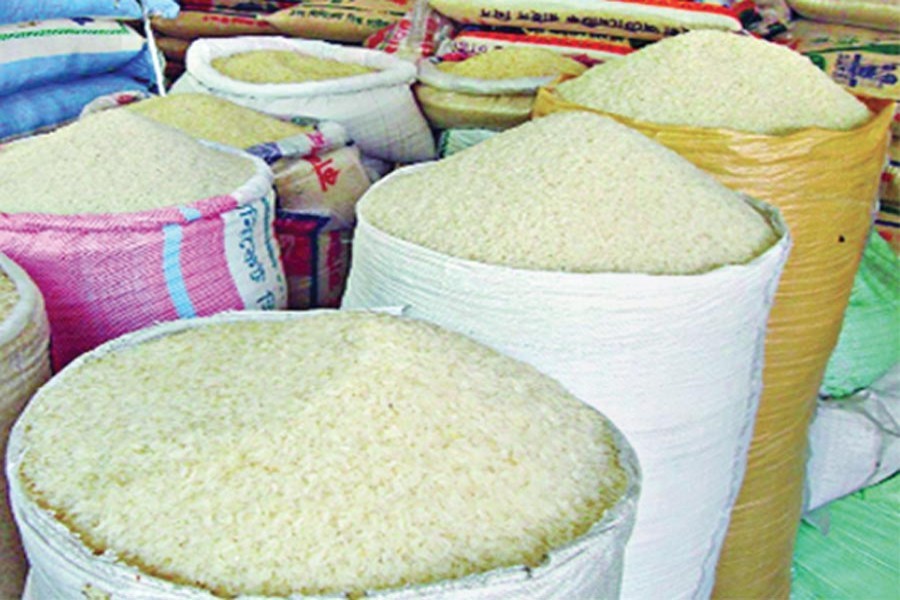Rice prices have gone up further in the retail market in less than two weeks, but reasons behind such a surge remain unascertained.
As always, millers and traders play a trump of increased prices of paddy they sourced from farmers.
But experts have rejected their claim and blamed a strong nexus between millers and traders for this hike.
Prices of many rice varieties rose by Tk 3.0-4.0 a kilogram both in retail and wholesale trade in the capital and elsewhere for the past seven days.
Coarse rice like seasonal Swarna, mostly consumed by low-income groups, sold at Tk 40-44 a kg on Saturday in the city, from Tk 38-Tk 40 a week ago.
Medium-quality Brridhan-28 and 29 sold at Tk 50-54, finer variety Miniket and Jeerashail at Tk 55-66 and Najirshail at Tk 62-70 based on quality.
Rice rose up in prices by Tk 80-100 per sack [50 kg] in Kushtia, Rangpur, Dinajpur, Nilphamari, Pabna and Jashore mill gates in the past 10 days.
The Bangladesh Auto Major Husking Mills Owners Association (BAMHMOA) made the disclosures.
Rice price is rising at a time when farmers had a good harvest in Aman harvest and got an all-time high yield in the last Boro season (April-June period).
Aman growers sold paddy at three-year low prices from mid-November to mid-December in 2018, according to the Department of Agricultural Marketing (DAM).
The Bangladesh Bureau of Statistics (BBS) is yet to estimate the total production of rice in the just concluded Aman season.
But overall production is expected to exceed the government target of 1.41 million tonnes in fiscal year (FY) 2018-2019, said officials.
Rice production was 36.2 million tonnes in FY '18 against the total requirement of 32.0 million tonnes, according to food ministry.
At the same time, stocks of food grain at public warehouses are now more than 1.05 million tonnes, shows the data of the ministry.
DAM deputy director (research/market linkage) Dewan Ashraful Hossain told the FE that the recent rice price hike is abnormal with ample market supply for good Aus and Aman harvests.
He said farmers also sold paddy at 30-40 per cent below the government's procurement rate in the ongoing Aman harvesting season.
The mill cost of Swarna rice is not more than Tk 29 a kg now, Mr Hossain told the FE.
Dr Wais Kabir, executive director of state-run Bangladesh Krishi Gobeshona Foundation, said millers and their allies have a firm hold on the market.
Paddy prices started increasing when farmers have no crop at their hand, he stated.
Mr Kabir said strict monitoring in milling areas and big wholesale markets are needed to combat any artificial price hike.
He said 28 per cent duty was re-imposed on rice import for the sake of the local peasantry. "But they aren't getting any benefit from this duty imposition."
The government should rethink higher import duty if the millers continue to raise prices, Mr Kabir observed.
However, import was considerably as lower as 0.106 million tonnes in the first six months of FY '19, according to the Directorate General of Food (DGoF).
It was 2.1 million tonnes in the same period of FY '18.
When asked, BAMHMOA president KM Layek Ali said solvent farmers and traders hoarded a big chunk of Aman paddy which has caused the hike in paddy prices.
Swarna paddy now sells at Tk 700-720 a maund which was Tk 600-620 even a few days back, he told the FE.
"We are selling Swarna rice at Tk 32 a kg at mills," the trade leader said.
However, rice prices are falling in the global market.
Food ministry said Indian, Thai and Vietnamese parboiled rice (5.0 per cent broken) is priced at $348-376 a tonne now against $351-380 a tonne a week ago.


